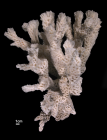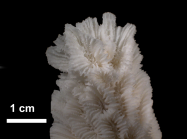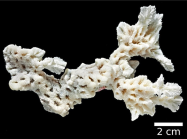WoRMS taxon details
Australogyra Veron & Pichon, 1982
267249 (urn:lsid:marinespecies.org:taxname:267249)
accepted
Genus
Platygyra zelli Veron, Pichon & Best, 1977 accepted as Australogyra zelli (Veron, Pichon & Best, 1977) (type by original designation)
marine, fresh, terrestrial
Veron JEN, Pichon M. (1982). Scleractinia of Eastern Australia – Part IV. Family Poritidae. <em>Australian Institute of Marine Science Monograph Series.</em> 5: 1-159. [details]
Description 'This species was described in Part II, p. 110 as Platygyra zelli, where it was noted that “the ramose growth form of...
Description 'This species was described in Part II, p. 110 as Platygyra zelli, where it was noted that “the ramose growth form of this species, combined with the normal lack of a columella, separates it from all other Platygyra and makes its generic affinities obscure... As this is a monospecific genus, its characters are those of zelli. [“Colonies are up to 25 cm high and have main branches 1.5–3 cm in diameter. Actively growing branch ends are composed of intricate arrays of thecae and elongated septa reminiscent of branch tips of Hydnophora rigida on a larger scale. Dead skeleton forms the base of most colonies. The valleys are short and usually monocentric. The walls are thick (2–4 mm) especially towards the base of colonies where skeletal parts are heavily calcified. Valleys are usually shallow with smooth blister-like floors. There is usually no sign of a columella, although elongated, recurved septal dentations are occasionally found and occasionally these form a distinct columella. The septa are similar to those of P. daedalea and P. lamellina. They are dentate and have fine granulations on their sides. Some dentations are twisted to form tiny horizontal plates fringed with granulations, presumably sclerodermites.” (Veron et al., 1977: 110)]' (Veron and Pichon, 1982: 138) [details]
Hoeksema, B. W.; Cairns, S. (2024). World List of Scleractinia. Australogyra Veron & Pichon, 1982. Accessed through: World Register of Marine Species at: https://www.marinespecies.org/aphia.php?p=taxdetails&id=267249 on 2024-04-19
Date
action
by
![]() The webpage text is licensed under a Creative Commons Attribution 4.0 License
The webpage text is licensed under a Creative Commons Attribution 4.0 License
original description
Veron JEN, Pichon M. (1982). Scleractinia of Eastern Australia – Part IV. Family Poritidae. <em>Australian Institute of Marine Science Monograph Series.</em> 5: 1-159. [details]
context source (Hexacorallia) Fautin, Daphne G. (2013). Hexacorallians of the World. (look up in IMIS) [details]
additional source Huang D, Benzoni F, Fukami H, Knowlton N, Smith ND, Budd AF (2014) Taxonomic classification of the reef coral families Merulinidae, Montastraeidae, and Diploastraeidae (Cnidaria: Anthozoa: Scleractinia). Zoological Journal of the Linnean Society 171: 277–355. [details]
additional source Veron JEN. (2000). Corals of the World. Vol. 1–3. <em>Australian Institute of Marine Science and CRR, Queensland, Australia.</em> [details]
additional source Budd AF, Fukami H, Smith ND, Knowlton N. (2012). Taxonomic classification of the reef coral family Mussidae (Cnidaria: Anthozoa: Scleractinia). <em>Zoological Journal of the Linnean Society.</em> 166 (3): 465-529., available online at https://doi.org/10.1111/j.1096-3642.2012.00855.x [details]
context source (Hexacorallia) Fautin, Daphne G. (2013). Hexacorallians of the World. (look up in IMIS) [details]
additional source Huang D, Benzoni F, Fukami H, Knowlton N, Smith ND, Budd AF (2014) Taxonomic classification of the reef coral families Merulinidae, Montastraeidae, and Diploastraeidae (Cnidaria: Anthozoa: Scleractinia). Zoological Journal of the Linnean Society 171: 277–355. [details]
additional source Veron JEN. (2000). Corals of the World. Vol. 1–3. <em>Australian Institute of Marine Science and CRR, Queensland, Australia.</em> [details]
additional source Budd AF, Fukami H, Smith ND, Knowlton N. (2012). Taxonomic classification of the reef coral family Mussidae (Cnidaria: Anthozoa: Scleractinia). <em>Zoological Journal of the Linnean Society.</em> 166 (3): 465-529., available online at https://doi.org/10.1111/j.1096-3642.2012.00855.x [details]
 Present
Present  Inaccurate
Inaccurate  Introduced: alien
Introduced: alien  Containing type locality
Containing type locality
From editor or global species database
Comparison As suggested by the original description (Veron and Pichon, 1982: 138), it shares almost all characters with Platygyra, differing only in having a compact or no columella. Our character trace suggests that this state is plesiomorphic, and hence no apomorphies are yet present for the genus. The ramose growth form also distinguishes it from Platygyra. Molecular data would further clarify its phylogenetic placement. [details]Description 'This species was described in Part II, p. 110 as Platygyra zelli, where it was noted that “the ramose growth form of this species, combined with the normal lack of a columella, separates it from all other Platygyra and makes its generic affinities obscure... As this is a monospecific genus, its characters are those of zelli. [“Colonies are up to 25 cm high and have main branches 1.5–3 cm in diameter. Actively growing branch ends are composed of intricate arrays of thecae and elongated septa reminiscent of branch tips of Hydnophora rigida on a larger scale. Dead skeleton forms the base of most colonies. The valleys are short and usually monocentric. The walls are thick (2–4 mm) especially towards the base of colonies where skeletal parts are heavily calcified. Valleys are usually shallow with smooth blister-like floors. There is usually no sign of a columella, although elongated, recurved septal dentations are occasionally found and occasionally these form a distinct columella. The septa are similar to those of P. daedalea and P. lamellina. They are dentate and have fine granulations on their sides. Some dentations are twisted to form tiny horizontal plates fringed with granulations, presumably sclerodermites.” (Veron et al., 1977: 110)]' (Veron and Pichon, 1982: 138) [details]
Diagnosis Colonial, with intracalicular budding only. Corallites monomorphic, uniserial and ramose; monticules absent. Walls fused. Calice width medium (4–15 mm), with medium relief (3–6 mm). Costosepta confluent. Septa in < 3 cycles (< 24 septa). Free septa present but irregular. Septa spaced 6–11 septa per 5 mm. Costosepta equal in relative thickness. Columellae trabecular but compact (1–3 threads) or absent, < 1/4 of calice width, and continuous among adjacent corallites. Paliform (uniaxial) lobes absent. Epitheca well developed and endotheca low-moderate (tabular). Tooth base at mid-calice circular. Tooth tip at mid-calice irregular; tip orientation perpendicular to septum. Tooth height low (< 0.3 mm) and tooth spacing medium (0.3–1 mm), with > 6 teeth per septum. Granules aligned on septal face, perpendicular to septal margin; weak (rounded). Interarea palisade. Walls formed by dominant trabeculotheca and partial septotheca; abortive septa absent. Thickening deposits fibrous. Costa center clusters weak; < 0.3 mm between clusters; medial lines weak. Septum center clusters weak; < 0.3 mm between clusters; medial lines strong. Transverse crosses absent. Columella centers aligned. [details]
Original description The genus was established by Veron & Pichon (1982) in an addendum to a monograph on Poritidae. [details]
Remark Australogyra Veron and Pichon, 1982: 138 is a monotypic genus sister to Platygyra on the morphological phylogeny. This relationship is reflected in its taxonomic history, as Australogyra zelli was initially described as a Platygyra species, and only put in its own genus later. [details]
| Language | Name | |
|---|---|---|
| English | Hydnophorahorn coralantler coral | [details] |


